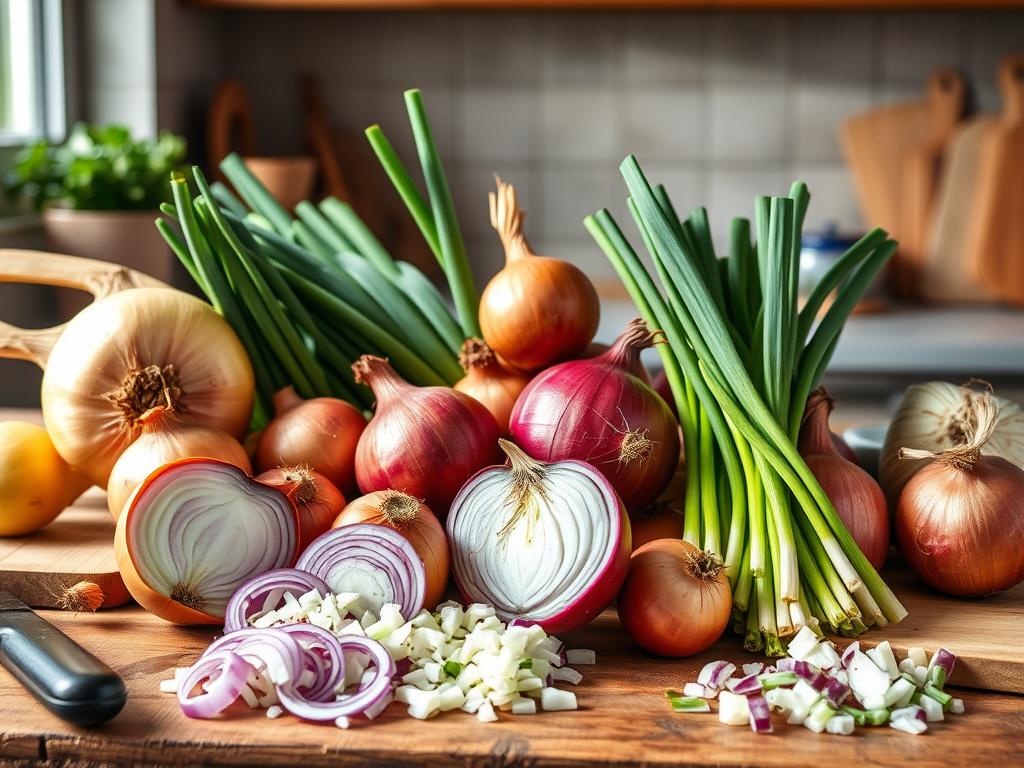Imagine stepping into a kitchen where the air is thick with the fragrance of something savory simmering away, and there it is—onion, the unsung heroes of our meals. Whether it’s that first slice that brings a tear to your eye or the rich flavor that transforms a simple dish into something remarkable, onion have an undeniable hold on our culinary experience. Their versatility ensures they can be at the heart of a hearty stew, tossed into a fresh salad, or even featured in gourmet dishes. Understanding the benefits of onions goes beyond flavor; it taps into their remarkable health contributions, enhance the taste of your dishes, and make cooking with onions a ritual in kitchens around the world.
The essential role that onions play in our cooking extends far beyond mere flavor enhancement. Packed with nutrients, they offer various onion health benefits that can aid in everything from boosting immunity to improving digestion. When you incorporate onions into your meals, you’re not just cooking; you’re nourishing your body, creating memories, and laying a foundation for healthier living. However, as powerful as they are, it’s equally important to know how to store and prepare them correctly to maximize their potential and enhance your kitchen experience.
Key Takeaways
- Onion are essential for flavor and nutrient-rich cooking.
- They can be used in various forms—from raw to caramelized.
- Onion have impressive shelf life when stored properly.
- Cooking with onion enhances the taste profiles of countless dishes.
- Proper storage conditions can prolong the usability of onion.
The Nutritional Benefits of Onions
Onion are not just a flavorful addition to meals; they pack a significant nutritional punch. Their contribution to daily nutrition is remarkable, offering a variety of essential vitamins and minerals. Understanding the nutritional benefits of onion can help you appreciate their role in a healthy diet.
Packed with Essential Vitamins and Minerals
A medium onion, weighing about 110g, is low in calories but high in nutrients. It contains:
| Nutrient | Amount (per 110g) | % Daily Value |
|---|---|---|
| Calories | 44 | – |
| Protein | 1.2g | – |
| Carbohydrates | 10.3g | – |
| Sugars | 4.7g | – |
| Fiber | 1.9g | – |
| Potassium | 3.4% DV | 3.4% |
| Vitamin C | 9% DV | 9% |
Given that Americans consume less than half of the recommended daily value for potassium, onions serve as an excellent source to bridge this gap. Additionally, onion nutrition facts highlight their role in providing essential nutrients like vitamin B6 and manganese.
Low-Calorie, High-Flavor Ingredient
Onions represent a low-calorie option, making them ideal for healthy eating without sacrificing flavor. Their versatility allows them to enhance salads, soups, and various dishes. Incorporating these nutrient-dense vegetables can elevate your meals while supporting weight management.
Antioxidant Properties for Better Health
The onion health benefits extend to their rich antioxidant content, particularly quercetin, which has shown promising effects on health. Studies indicate that this compound may contribute to lower blood pressure and reduced cholesterol levels. A 2015 study showed a daily intake of quercetin-rich onion extract could decrease systolic blood pressure in those with hypertension. Another notable study suggested that consuming 80-120g of raw red onion could lower total cholesterol levels over an eight-week period.

Overall, the nutritional benefits of onion can support various aspects of health, from promoting heart health to enhancing digestive function. Their prebiotic properties improve gut health by fostering friendly bacteria, contributing to a robust immune system.
Different Types of Onions and Their Uses
Onions, a staple in many kitchens, come in various types, each with unique flavors and culinary uses. Understanding the distinct characteristics of different types of onions can greatly enhance your cooking with onions and elevate the overall taste of your dishes.
Yellow Onion: The Kitchen Workhorse
Yellow onions account for nearly 90 percent of storage onion grown in the U.S., making them the most frequently used variety. Their strong, pungent flavor holds up remarkably well to slow cooking, making them excellent for caramelizing and wide-ranging recipes. They are versatile and can be used in soups, stews, and sauces, enhancing the depth of flavor in any dish.
Red Onion: Great for Salads and Salsas
Known for their vibrant color, red onion are often incorporated into salads, grilling, and pickling due to their distinctive peppery and somewhat spicy taste. These onions are sweetest from March to September, making them a fantastic choice for fresh dishes. They add an appealing crunch and a splash of color to salsas, enhancing their visual and flavor profiles.
Sweet Onion: A Flavorful Addition to Various Dishes
Sweet onions, such as Vidalia and Walla Walla, offer a mild flavor profile with a hint of sweetness. These onion are ideal for salads, relishes, and garnishes, providing a soft crunch that enhances many recipes. The gentle sweetness complements other ingredients beautifully, making sweet onion a favorite in many home kitchens. Other varieties, like Maui onion, share similar qualities and expand the types of onions available for various culinary creations.

| Type of Onion | Flavor Profile | Best Uses |
|---|---|---|
| Yellow Onion | Pungent, strong | Soups, stews, caramelizing |
| Red Onion | Spicy, slightly sweet | Salads, grilling, pickling |
| Sweet Onion | Mild, sweet | Salads, relishes, garnishes |
| White Onion | Slightly sweet | Mexican dishes, grilling |
| Shallots | Mild, garlic-onion hybrid | Dressings, sauces |
| Green Onion (Scallions) | Mild, herbaceous | Asian dishes, garnishes |
How to Properly Store Onions
Correctly storing onion plays a crucial role in their longevity and flavor retention. Following specific onion storage tips can ensure maximum freshness for an extended period. Gathered below are key insights on how to store onions effectively, along with common errors to avoid.
Ideal Storage Conditions for Longevity
Onion thrive best in cool, dry, and well-ventilated environments. Temperature plays a vital role, with the optimum range being between 30°F and 50°F, where onion can last for up to a year. If stored improperly, their lifespan reduces significantly, often lasting only a few weeks.
Use a perforated bag or a woven basket, which allows for airflow while keeping moisture at bay. Avoid plastic bags, as these can trap moisture and promote mold. For cut onion, use an airtight container and store them in the refrigerator, where they can safely last for about a week. If you’re preparing onions for cooking, freezing them extends their shelf life for several months.
Common Mistakes to Avoid
Storing onions in the refrigerator is a widespread error that can lead to spoilage due to excess moisture. Additionally, keeping onions and potatoes close together can cause each to deteriorate faster. Proper education on how to store onions can help mitigate these issues.
Remember that fresh alliums, such as scallions, leeks, and chives, require different conditions. When not cured for long-term storage, these should be kept in the fridge, ideally wrapped in a damp paper towel to maintain moisture without causing rot.
By adhering to these guidelines, your onion should remain fresh and flavorful, enhancing your culinary endeavors.
Tips for Cooking with Onions
Cooking with onion can transform a simple dish into something exceptional. By mastering different techniques, you can enhance the flavor and texture of your meals. Understanding the differences between sautéing and caramelizing will give your onion recipes an extra layer of depth. While sautéing retains a crunch and strong flavor, caramelizing develops rich, sweet profiles through slow cooking.
Sautéing vs. Caramelizing: What’s the Difference?
Sautéing onion typically involves cooking them quickly over medium-high heat. This method allows the onion to soften while maintaining some of their original flavor and texture. In contrast, caramelizing requires low heat and patience, often taking up to 45 minutes. This slower process brings out the natural sugars, resulting in a deep, sweet flavor. To speed up caramelization, consider adding a pinch of sugar or baking soda, but using oil instead of butter is recommended for a better smoke point.
How to Cut Onions Without Tears
Chopping onion can sometimes result in tears due to the release of irritating enzymes. To reduce this discomfort, try chilling the onion beforehand or cutting them under running water. Wearing contact lenses or goggles can also create a protective barrier. When cutting, aim to chop from pole to pole to minimize breaking more cells, which release irritants.
Creative Ways to Incorporate Onions in Recipes
Onions are incredibly versatile and can be incorporated into a range of dishes. Use yellow onion for their adaptability in various recipes or red onion for a fresh crunch in salads. Consider infusing flavors in sauces, stir-fries, or soups by starting with a solid onion base. Adding onion to your salad or on top of pizza provides extra texture and flavor, while sweet onions and shallots work beautifully when caramelized.
| Type of Onion | Best Uses | Flavor Profile |
|---|---|---|
| Yellow Onion | Versatile in various recipes | Strong, slightly sweet |
| Red Onion | Raw in salads, grilling | Sharp, crunchy |
| White Onion | Cooking, salsas | Pungent |
| Sweet Onion | Caramelizing | Mild, sweet |
| Green Onion | Garnishing, stir-fries | Fresh, bright |

With these handy tips, exploring the world of cooking with onion becomes an enjoyable journey. Try incorporating these techniques and suggestions into your onion recipes for delightful results. For a delicious example of using onion, check out this ratatouille recipe that highlights the flavorful benefits of various vegetables, including onions.
Onion Varieties: A Global Perspective
Onions hold a significant place in various cuisines worldwide, making them indispensable in countless dishes. The incredible diversity of types of onion enriches culinary experiences, inviting home chefs to explore flavors and traditions across the globe.
Celebrating Onions in Different Cuisines
Different types of onions feature prominently in recipes around the world. For example, red onions add a pop of color and crunch to fresh salads, while amber supermarket onions serve as the savory base for numerous cooked dishes. Cippoline, often found at farmers’ markets, have a distinctive flat shape and sweetness perfect for caramelizing in delectable curries, while shallots impart a mild flavor that enhances sauces and dressings.
Some notable onion varieties include:
- Ailsa Craig: An heirloom variety, cherished for its sweetness.
- Vidalia: Known for its mild taste, it thrives in the specific sulfur-rich soil of Georgia.
- Maui: Grown in Hawaii, this variety is sweet and versatile.
- Texas 1015: Distinguished for its larger size and excellent flavor.
The Role of Onions in Traditional Dishes
Onions form the backbone of many traditional dishes. Whether it be the comforting French onion soup, rich curries, or even roasted chicken with caramelized onion, their unique flavor profiles elevate meals. Cooking techniques such as sweating, browning, and roasting allow onion to release their natural sweetness, enhancing the overall dish.
Among different types of onion, sweet ones with higher water content, such as Vidalia, are especially favored for raw applications, while storage varieties are ideal for cooked preparations. Their global cultivation reflects the essential role onion play in enriching culinary heritages.
Onion Recipes to Try at Home
Cooking with onions opens a delightful world of flavors, and there are plenty of delicious onion recipes to enhance your meals. One standout option is the classic French Onion Soup, where caramelized onions create a deep, sweet flavor that warms the soul. Perfect as an appetizer on chilly evenings, this dish incorporates layers of savory richness that can be made right in your own kitchen.
Classic French Onion Soup Recipe
Another fantastic recipe to consider is a Quick and Easy Onion Tart. This versatile dish serves as a wonderful appetizer or light meal, allowing you to experiment with various ingredients based on what’s in your pantry. Its flaky crust pairs beautifully with different types of onions, making it a go-to for those busy weeknights when you need something quick and satisfying.
Quick and Easy Onion Tart
Lastly, don’t underestimate the power of Creative Onion-Infused Sauces. These sauces can elevate any dish, whether you wish to enhance grilled meats or dress a fresh salad. The versatility of onions shines through in these recipes, highlighting how this humble vegetable can play a starring role in your culinary creations. Explore more onion recipes, including unique preparations like the Five Onion Tart, by visiting this collection.











